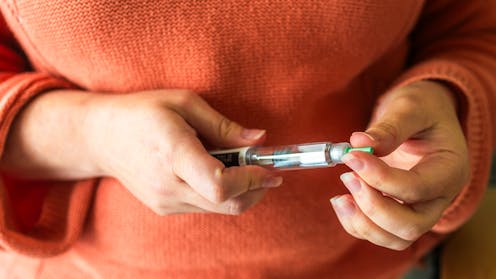The weight loss drug Mounjaro has been approved to treat sleep apnoea. How does it work?
- Written by The Conversation

Last week, Australia’s Therapeutic Goods Administration (TGA) approved the weight-loss drug Mounjaro to treat sleep apnoea, a condition in which breathing stops and starts repeatedly during sleep.
The TGA has indicated Mounjaro can be used to treat moderate to severe obstructive sleep apnoea in adults with obesity (a body-mass index of 30 or above).
The United States Food and Drug Administration approved the same drug for sleep apnoea last year.
So how could this drug, most commonly used for weight management and conditions such as type 2 diabetes, help people with sleep apnoea?
What is sleep apnoea?
Obstructive sleep apnoea is a common sleep disorder affecting almost 1 billion people worldwide. It’s characterised by repeated closures of the airway during sleep (called “apnoeas”). These can be partial or complete closures, meaning breathing can become shallow or stop completely.
As well as causing fragmented sleep, repeated collapse of the airway disrupts oxygen flow to the body. This strains the heart and contributes to an increased risk of cardiovascular and metabolic complications such as diabetes, high blood pressure and stroke.
One of the key risk factors for obstructive sleep apnoea is obesity. About 80% of people with the condition live with obesity. In fact, obesity and sleep apnoea share a bidirectional relationship, with obesity increasing the risk of developing sleep apnoea, and vice versa.
Obesity increases the risk of sleep apnoea by adding fat around the neck, which narrows the airway and impacts breathing during sleep.
In turn, sleep apnoea can contribute to weight gain by disrupting hormones that regulate hunger (ghrelin) and fullness signals (leptin). Fatigue also contributes, making it harder to maintain a healthy weight and easier to gain weight over time, creating a vicious cycle where each condition worsens the other.
Weight loss is a key part of treating sleep apnoea. It helps reduce the severity of symptoms and also lowers the risk of heart disease and other health problems which may arise as a result of sleep apnoea. However, achieving and sustaining weight loss through lifestyle changes is often challenging.
A continuous positive airway pressure (CPAP) machine is generally the first-line therapy for managing moderate to severe sleep apnoea. It delivers a steady stream of pressurised air through a mask to keep the airway open during sleep, which stabilises breathing and improves sleep quality.
Despite being an effective treatment, many people find the CPAP machine uncomfortable, unattractive or hard to use regularly. This can mean people don’t always stick to it.
Given the significant human and economic costs of sleep apnoea it’s pertinent to keep exploring new prevention and management strategies.
What is Mounjaro, and how could it help people with sleep apnoea?
Mounjaro is the brand name of a drug called tirzepatide. Elsewhere, it goes by other brand names, such as Zepbound.
Tirzepatide works by mimicking two hormone receptors in the gut, glucagon-like peptide-1 (GLP-1) and glucose-dependent insulinotropic polypeptide (GIP).
These two hormones play a key role in regulating our appetite, food intake and blood sugar levels. GLP-1 and GIP are released naturally in the body when we eat, but by mimicking their effects, tirzepatide allows people to feel fuller with smaller meals.
If a person is eating less overall, this can lead to weight loss.
In a study of 469 people with obesity and moderate to severe obstructive sleep apnoea, one year of tirzepatide treatment was associated with up to a 60% reduction in sleep apnoea severity. This is compared to a 3% reduction in people receiving a placebo.
In addition, evidence shows tirzepatide is associated with improvements in several key health indicators, including reduced systemic inflammation, enhanced insulin sensitivity and lower blood pressure. Changes such as these may improve respiratory function and help protect against cardiovascular and metabolic complications, which are common outcomes of untreated sleep apnoea.
Are there any side effects?
While Mounjaro could be helpful for people with sleep apnoea, gastrointestinal side effects are relatively common with this medication. These can include nausea, vomiting, diarrhoea, constipation and loss of appetite. These side effects typically go away as the person gets used to the medication.
Some patients have also reported gallbladder problems.
Despite these concerns, there is an interest in Mounjaro as sleep apnoea treatment as it provides the first pharmaceutical option for a condition that has traditionally relied on mechanical treatments such as CPAP machines.
That said, it’s important to note Mounjaro is indicated for use in patients with obesity, and not all patients with sleep apnoea are overweight or obese.
In some people of a healthy weight, narrow skeletal structure or upper airway anatomy, such as larger soft palates (which can reduce airway space and make it more prone to collapse during sleep), could contribute to obstructive sleep apnoea.
For those patients, non-pharmacological treatment options such as mandibular advancement devices (oral appliances that move the lower jaw forward and keep the airway open) and upper airway surgery may be needed to effectively manage the condition.
Mounjaro is given as a weekly injection. In Australia, Mounjaro is not currently subsidised under the Pharmaceutical Benefits Scheme and is available only by private prescription, with prices beginning at around A$395 per month. The significant out-of-pocket cost will limit access to Mounjaro for many patients.
Mounjaro’s approval for the treatment of sleep apnoea may offer new hope for many people. But considering the diversity in patient presentations and limited data from large population studies, it’s too early to say whether this will transform sleep apnoea care in Australia.







